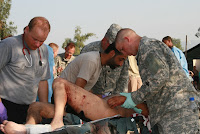 During the ceremony, we received word that there had been a suicide bombing at the funeral of the governor of Khost province in eastern Afghanistan who had been assassinated the day before. According to press reports, the blast during the funeral occurred near a tent where more than 1,000 people had congregated.
During the ceremony, we received word that there had been a suicide bombing at the funeral of the governor of Khost province in eastern Afghanistan who had been assassinated the day before. According to press reports, the blast during the funeral occurred near a tent where more than 1,000 people had congregated.The local hospital was beset with casualties and realized it did not have the ability to treat all of the injured. Many were turned away and told to seek treatment at FOB Salerno. Shortly after learning of the attack, preparations began to receive mass casualties at the front gate. I helped the medical staff prepare a triage area at the front gate by moving stretchers and medical supplies. It seemed like there wasn't much time between the time we learned of the suicide bombing and the casualties began arriving.
 The medical staff worked at a furious pace to check and document injuries, distinguish the severity of injuries and begin treatment. There seemed to be more people injured than what was manageable. As the injured arrived outside the gates of Salerno continued to grow, it was obvious that more people would be needed to help treat the wounded. An announcement was made over the loudspeaker requesting volunteers, so Soldiers and contractors from various disciplines turned out to support the effort.
The medical staff worked at a furious pace to check and document injuries, distinguish the severity of injuries and begin treatment. There seemed to be more people injured than what was manageable. As the injured arrived outside the gates of Salerno continued to grow, it was obvious that more people would be needed to help treat the wounded. An announcement was made over the loudspeaker requesting volunteers, so Soldiers and contractors from various disciplines turned out to support the effort.Casualties continued to come to the gates of Salerno throughout the day and into the night. As evening approached, KBR employees set up generators and floodlights so the rescue work could continue working.
 Most of the caregivers had been working non-stop and not eaten or taken a break since breakfast. I called the dining facility and asked if there was anyway they could prepare food, drinks and snacks for two-hundred people and bring everything to the hospital entrance. The normal treatment area for sick and wounded Soldiers now became an area for treating the weary caregivers and volunteers' hunger.
Most of the caregivers had been working non-stop and not eaten or taken a break since breakfast. I called the dining facility and asked if there was anyway they could prepare food, drinks and snacks for two-hundred people and bring everything to the hospital entrance. The normal treatment area for sick and wounded Soldiers now became an area for treating the weary caregivers and volunteers' hunger.A cafeteria-style serving area was set up and a line formed outside the entrance to the hospital and into the street until everyone was fed. Food was brought to the surgical and emergency medical teams as they were unable to leave their posts.
 The surgeries continued throughout the night and into the morning. On September 12th, the most critically wounded patients were evacuated for further treatment.
The surgeries continued throughout the night and into the morning. On September 12th, the most critically wounded patients were evacuated for further treatment.The day of remembrance for the victims of September 11, 2001, and the reason for our being in Afghanistan had turned full circle. We now had first-hand experience of the victims, emergency responders and caregivers of a suicide attack on a democracy, albeit one in its infancy, and only a microcosm of the events that unfolded in 2001.
